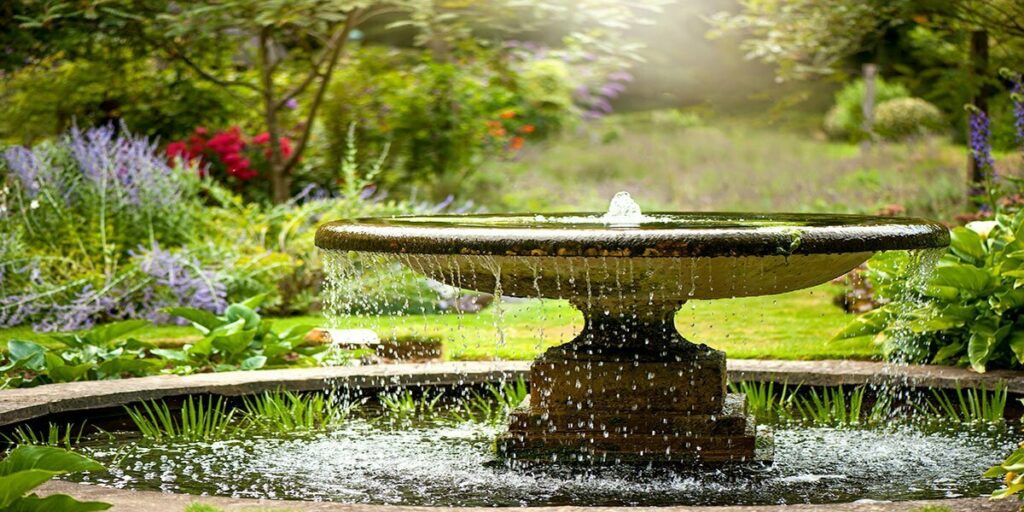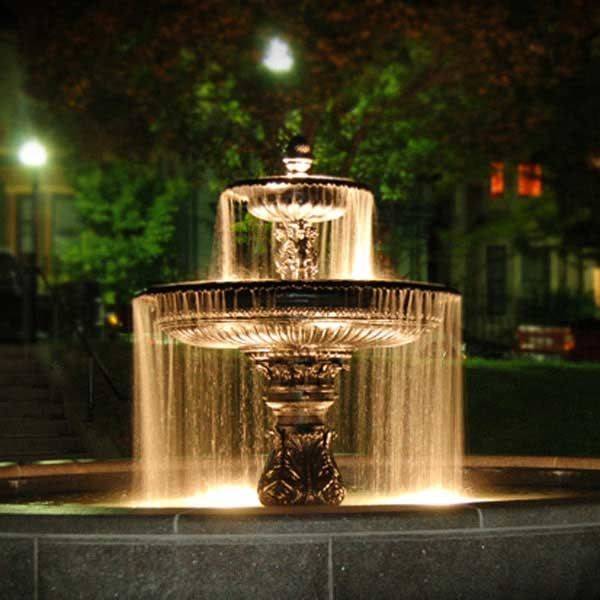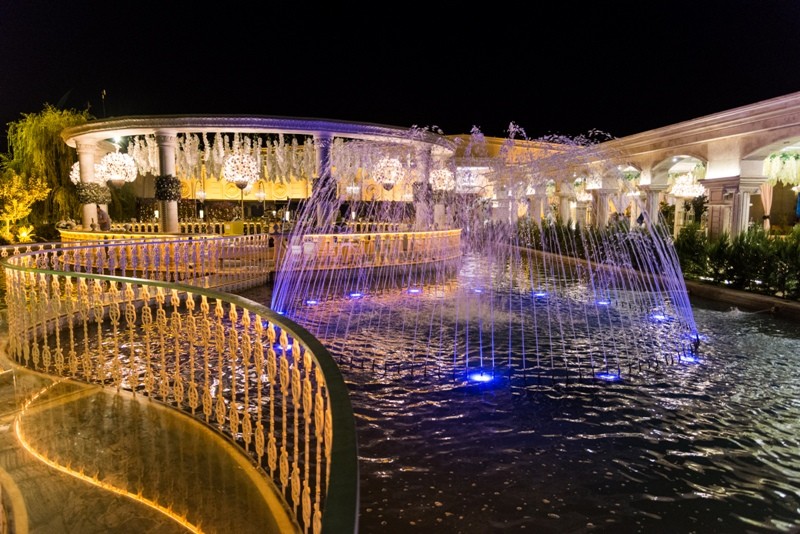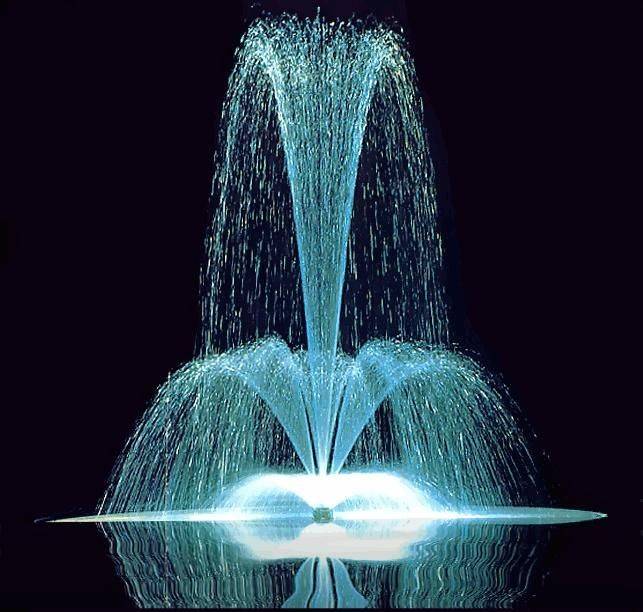Fountain lighting is one of the key elements in designing and beautifying both interior and exterior spaces, combining visual appeal with architectural art. Fountains, with their dynamic movements and the soothing sound of water, add a sense of freshness and life to the environment, and appropriate lighting can amplify this charm. Creative lighting techniques can create unique light patterns in combination with the movement of water, giving the space a dreamy and visually striking effect. In addition to its visual impact, fountain lighting can serve other functions, such as enhancing security at night and directing attention to a focal point. This art is recognized as a prominent decorative element in urban settings, gardens, parks, and even indoor spaces.

Impact of Lighting
Fountain lighting has a significant impact on its beauty and appeal, turning the space into a visual focal point.
- Creating Visual Beauty and Drawing Attention
Proper fountain lighting enhances its beauty, especially at night. The combination of water movement and colored lights creates a dynamic and captivating effect that can catch the attention of any viewer. - Emphasizing Fountain Design and Details
Lighting can highlight specific elements of the fountain, such as the water flow, jets, or surrounding decorations. This draws attention to the unique design and artistic details of the fountain. - Creating a Unique Atmosphere in the Space
The color and intensity of the light can evoke different feelings. Warm lights (yellow and orange) create a calming atmosphere, while cool lights (blue and white) enhance a sense of freshness and tranquility. Additionally, the use of multicolored lights can bring a sense of liveliness and energy to the space. - Creating Depth and Dimension in the Space
Proper lighting can add depth and dimension to the fountain, making it appear more three-dimensional and lifelike in the environment. This is particularly effective in small spaces, open areas, or garden landscaping. - Increasing Safety and Visibility at Night
In addition to enhancing beauty, fountain lighting improves visibility and safety at night. This is especially important in public spaces, gardens, and parks. - Enhancing the Architectural Design of the Environment
Fountain lighting can help create a greater harmony between the fountain design and its surrounding environment. By choosing colors and lighting intensities that complement the architecture of the space, the fountain becomes an integral part of the visual identity of the environment.
Impact of Lighting on Musical Fountains and Fountain lighting
- Enhancing Visual Beauty
Lighting with colored lamps and various techniques adds a stunning effect to musical fountains. The changing colors and interplay of lights can synchronize with the music, creating a beautiful and delightful visual display. - Creating Harmony with Music
Lighting that synchronizes with the rhythm and melody of the music can offer the audience an experience beyond a simple show. The harmonious combination of light and sound adds depth and dimension to the fountain display. - Highlighting Water Movement
Proper lighting can accentuate the movements and flows of the water, increasing its impact. By using spotlights and hidden lights, the dynamic and lively motion of the water can be showcased. - Enhancing Nighttime Effects
At night, lighting can give the musical fountain a special appeal, turning it into a visual attraction. Colored and moving lights can make the fountain shine in the dark and attract attention. - Improving Audience Experience
Appropriate lighting can improve the viewer’s experience, immersing them in the performance. These visual effects can create a deeper emotional connection with the audience and enhance their enjoyment of the show. - Increasing Safety
Proper lighting can contribute to the safety around the fountain, helping to prevent accidents and potential hazards.
Lighting PrinciplesProper lighting plays a crucial role in creating visual, functional, and emotional appeal in a space. To execute professional and effective lighting, the following principles must be observed:
- Clear Goal Setting
Before designing the lighting, it is essential to define the goal: - Aesthetic: Emphasizing specific elements and creating appealing visual effects.
- Functional: Providing adequate light for daily activities.
- Emotional: Creating a sense of calm, vitality, or energy in the environment.
2. Balance Between Natural and Artificial Light
Utilizing natural light helps reduce energy consumption and improves mental well-being.
Artificial lighting should be adjusted to complement natural light, ensuring optimal performance at different times of the day.
3. Choosing the Right Type of Light
- Direct light: To highlight specific elements (such as sculptures, artwork, or fountains).
- Indirect light: To create soft, uniform lighting across the space.
- Spotlights: For focusing on specific details.
- Ambient lighting: To provide general illumination.
4. Paying Attention to Color Temperature
- Warm lights (yellow and orange): Create a cozy and relaxing atmosphere, ideal for homes, restaurants, and hotels.
- Cool lights (white and blue): Best suited for workspaces, commercial areas, or places where focus is required.
- Neutral lights: Suitable for public spaces that need to balance a professional yet comfortable vibe.
5. Controlling Light Intensity and Distribution
- Light intensity: Should be adjusted according to the space and activities. For instance, reading areas require more light, while bedrooms need softer lighting.
- Light distribution: Avoid harsh shadows or overly bright spots. The light should be evenly distributed.
6. Layering Light
Lighting should be designed in three layers:
- General lighting: Overall illumination for the space.
- Task lighting: For specific activities such as reading or cooking.
- Accent lighting: To highlight decorative objects or architectural features.
7. Using Modern Technologies
- LED lights: High efficiency, lower energy consumption, and longer lifespan.
- Smart systems: Remote control of light intensity and color according to the environment.
- Motion sensors: To increase energy efficiency in less-used spaces.
8. Coordinating with Interior Design and Architecture
Lighting should harmonize with the colors, materials, and style of the interior design. Proper lighting can enhance the dimensions and feel of the space.
9. Ensuring Safety and Standards
Ensure the use of equipment that is resistant to moisture and heat (especially in kitchens, bathrooms, and outdoor spaces).
Avoid glare and overly intense lights that might be uncomfortable for the eyes.
10. Creativity and Flexibility
Lighting should not only be functional but also contribute to creating a unique atmosphere in the space. The use of adjustable, color-changing, and flexible lighting can enhance the visual and emotional appeal of the environment.

6 Lighting Techniques
Lighting is one of the essential elements in both interior and exterior design, and by using various techniques, different results can be achieved. Here, we explore six common and effective lighting techniques:
- Ambient Lighting
Goal: To provide uniform and general lighting for a space.
Features:
- This type of lighting is the most basic layer of illumination.
- Typically achieved with ceiling lights, chandeliers, or light panels.
- Creates a sense of comfort and functionality.
Application: In residential, office, and commercial spaces for general illumination.
2. Task Lighting
Goal: To provide sufficient light for specific activities such as reading, cooking, or working.
Features:
- More focused and brighter than ambient lighting.
- Uses desk lamps, under-cabinet lights, or adjustable lamps.
- Should prevent glare and unwanted shadows.
Application: Study desks, workstations, kitchens, and bathrooms.
3. Accent Lighting
Goal: To draw attention to specific points or objects.
Features:
- Typically three times brighter than ambient lighting.
- Uses spotlights, LED strips, or wall-mounted lights.
- Used to highlight artwork, sculptures, or architectural elements.
Application: Museums, galleries, and exhibition spaces.
4. Decorative Lighting
Goal: To create visual beauty and decorate the space.
Features:
- Primarily ornamental in nature, often designed to add aesthetic appeal.
- Uses chandeliers, modern pendant lights, or artistic wall sconces.
Application: Living rooms, restaurants, or luxury spaces.
5. Ambient Lighting Enhancements
Goal: To create a specific mood or atmosphere in the space.
Features:
- Uses indirect and soft lighting to enhance a sense of calm.
- Lighting via LED strips in false ceilings or behind furniture.
- Different light colors can be used to alter the ambiance of the space.
Application: Bedrooms, lounges, or sitting areas.
6. Architectural Lighting
Goal: To emphasize the architectural design of the space.
Features:
- Uses light to highlight lines, angles, and textures.
- Often uses hidden lights, floor lights, or recessed lighting.
- Helps showcase architectural details.
Application: Building facades, hallways, staircases, and modern spaces.

Lighting for Fountain in Banquet Halls
Fountain lighting in banquet halls helps enhance the beauty and appeal of spaces where people gather for various events and ceremonies. This lighting can include the use of natural lights, artificial lights, or a combination of both. The primary goal of this lighting is to create a beautiful and central atmosphere for the participants.
To light the fountain in banquet halls, several methods and techniques can be employed:
- Colored Lights: Using a variety of colored lights can create beautiful effects. Adjustable LED lights can be used to display different colors.
- Underwater Lights: Installing underwater lights in the fountain makes the water shine beautifully, creating a unique and mesmerizing effect.
- Spot Lighting: Using spotlights to highlight specific parts of the fountain and create a focus on them.
- Timers and Smart Control Systems: Using timers and smart control systems to schedule lighting timings and color changes.
- Dynamic Lighting Effects: Using moving lights and dynamic lighting effects to create movement and brilliant changes in the fountain.


 English
English العربية
العربية


















